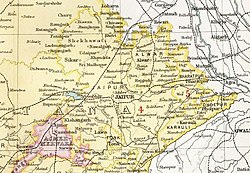รัฐชัยปุระ
รัฐชัยปุระ (อักษรโรมัน: Jaipur) เป็นรัฐมหาราชาในอินเดียในสมัยอีสต์อินเดียคัมปานี และบริติชราช รัฐลงนามในสนธิสัญญาถ่ายโอนสิทธิ์การปกครองให้กับอังกฤษในปี 1818 และเข้าร่วมกับอินเดียซึ่งพึ่งได้รับเอกราชในปี 1947[1][2] หลังการรวมเข้ากับอินเดียอย่างเป็นทางการ รัฐบาลอินเดียได้มอบเงินชดเชยแก่มหาราชา และยังคงยืนยันให้มีสิทธิพิเศษบางประการอยู่ รวมถึงยังสามารถใช้นามว่า มหาราชาแห่งชัยปุระ ได้[1] เรื่อยมาจนถึงปี 1971 หลังมีการประกาศใช้รัฐธรรมนูญแปรญัติฉบับที่ 26[3][4]
รัฐชัยปุระ | |||||||
|---|---|---|---|---|---|---|---|
| 1128–1949 | |||||||
 แผนที่รัฐชัยปุระในราชกิจจานุเบกษาอินเดีย | |||||||
| สถานะ |
| ||||||
| เมืองหลวง | ชัยปุระ | ||||||
| ภาษาทั่วไป | ธุนธรี, ฮินดี | ||||||
| การปกครอง | ราชาธิปไตย (1128–1818; 1947–1949) รัฐมหาราชา (1818–1947) | ||||||
| มหาราชา สวาอี | |||||||
• 1128 | ดูลหะ รายะ (แรก) | ||||||
• 1922–1949 | มาน สิงห์ ที่สอง (ท้าย) | ||||||
| ประวัติศาสตร์ | |||||||
• ก่อตั้ง | 1128 | ||||||
• เข้าร่วมอินเดีย | 1949 | ||||||
| สกุลเงิน | รูปีอินเดีย | ||||||
| |||||||
| ปัจจุบันเป็นส่วนหนึ่งของ | รัฐราชสถาน ประเทศอินเดีย | ||||||
ชื่อเดิมของรัฐคืออาเมร์ (Amer) ตั้งแต่ศตวรรษที่ 14 เรื่อยมาถึงปี 1727 ที่ซึ่งมีการสร้างราชธานีขึ้นใหม่ในชื่อ ชยปุร (ชัยปุระในปัจจุบัน) จึงได้เปลี่ยนชื่อรัฐใหม่เป็นรัฐชัยปุระเรื่อยมา[5]
อ้างอิง
แก้- ↑ 1.0 1.1 อ้างอิงผิดพลาด: ป้ายระบุ
<ref>ไม่ถูกต้อง ไม่มีการกำหนดข้อความสำหรับอ้างอิงชื่อramusack-pol-integration - ↑ Copland, Ian (16 May 2002), The princes of India in the endgame of empire, 1917–1947, Cambridge Studies in Indian History and Society, Cambridge University Press, p. 1, ISBN 9780521894364,
Between 1947 and 1949 all 600-odd ruling princes in India were pensioned off and their ancestral domains—the so-called 'princely states'—were submerged in the bodypolitic of the Indian union. Nowadays the few former rulers still alive are just ordinary citizens, while the ex-states survive—if at all—only in attenuated shape as components of larger administrative units. As a practical system of governance monarchy in India has been consigned to the dustbin of history.
- ↑ "The Constitution (26 Amendment) Act, 1971", indiacode.nic.in, Government of India, 1971, สืบค้นเมื่อ 9 November 2011
- ↑ Schmidt, Karl J. (1995). An atlas and survey of South Asian history. M.E. Sharpe. p. 78. ISBN 978-1-56324-334-9.
Although the Indian states were alternately requested or forced into union with either India or Pakistan, the real death of princely India came when the Twenty-sixth Amendment Act (1971) abolished the princes' titles, privileges, and privy purses.
- ↑ Princely States of India

